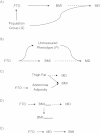Credible Mendelian randomization studies: approaches for evaluating the instrumental variable assumptions
- PMID: 22247045
- PMCID: PMC3366596
- DOI: 10.1093/aje/kwr323
Credible Mendelian randomization studies: approaches for evaluating the instrumental variable assumptions
Abstract
As with other instrumental variable (IV) analyses, Mendelian randomization (MR) studies rest on strong assumptions. These assumptions are not routinely systematically evaluated in MR applications, although such evaluation could add to the credibility of MR analyses. In this article, the authors present several methods that are useful for evaluating the validity of an MR study. They apply these methods to a recent MR study that used fat mass and obesity-associated (FTO) genotype as an IV to estimate the effect of obesity on mental disorder. These approaches to evaluating assumptions for valid IV analyses are not fail-safe, in that there are situations where the approaches might either fail to identify a biased IV or inappropriately suggest that a valid IV is biased. Therefore, the authors describe the assumptions upon which the IV assessments rely. The methods they describe are relevant to any IV analysis, regardless of whether it is based on a genetic IV or other possible sources of exogenous variation. Methods that assess the IV assumptions are generally not conclusive, but routinely applying such methods is nonetheless likely to improve the scientific contributions of MR studies.
Figures




Comment in
-
Re: "credible mendelian randomization studies: approaches for evaluating the instrumental variable assumptions".Am J Epidemiol. 2012 Sep 1;176(5):457-8; author reply 458. doi: 10.1093/aje/kws250. Epub 2012 Jul 31. Am J Epidemiol. 2012. PMID: 22850793 No abstract available.
-
Re: "credible mendelian randomization studies: approaches for evaluating the instrumental variable assumptions".Am J Epidemiol. 2012 Sep 1;176(5):456-7. doi: 10.1093/aje/kws249. Epub 2012 Jul 31. Am J Epidemiol. 2012. PMID: 22850794 No abstract available.
References
-
- Davey Smith G, Ebrahim S. ‘Mendelian randomization’: can genetic epidemiology contribute to understanding environmental determinants of disease? Int J Epidemiol. 2003;32(1):1–22. - PubMed
-
- Smith GD, Ebrahim S. Mendelian randomization: prospects, potentials, and limitations. Int J Epidemiol. 2004;33(1):30–42. - PubMed
-
- Davey Smith G, Ebrahim S, Lewis S, et al. Genetic epidemiology and public health: hope, hype, and future prospects. Lancet. 2005;366(9495):1484–1498. - PubMed
Publication types
MeSH terms
Substances
Grants and funding
LinkOut - more resources
Full Text Sources
Research Materials

